|
Die postalische Lage (1994–)
Das Postministerium (Ministry of Telecom & Information Technology) beschreibt die Situation während der israelischen Besetzung wie folgt:
|
|
Post was affected by the Israeli occupation of Palestine and characterized by the Israeli post features. As the Palestinian people, post suffered from the occupation discrimination.
Israel made a difference between Arabs and Jewish regarding rights and duties even in sending and receiving mail letters, while the Palestinian employees' skills were the reason of post work continuity as a patriotic duty at that time.
Post service troubles can be clarified as follows:—
- Revealing the privacy of the coming and abroad mail dispatches by having a look on its contents and putting it under permanent control.
- Imposing restrictions on the abroad mail weight less than what is allowed in the universal post convention.
- Confiscating some of the contents of the coming dispatches and parcels after opening it (like electronic sets and others).
- Delaying sending the dispatches and parcels as well as its delivery under the pretext of security control.
[...]
The abroad mail services were only the mail addressed to the foreign countries due to indirect mail exchange with Arab countries as a result of the occupation and the Arab boycott to the occupation.
Post sector became a commercial market for Israeli benefits by selling international reply coupons used for dispatches to Arab countries via London or Cyprus for 5$ for each letter.
While post duties and services were selling post stamps, revenue stamps, international reply coupons, delivering mail, selling stamps of Ministry of Interior for permits and visits, in addition to post bank services.
Quelle: Website des Ministry of Telecom & Information Technology.
|
|
|
|
Die israelischen Besatzungstruppen schlossen alle Posteinrichtung im Gazastreifen am 4.05.1994, in Jericho am 9.5.1994, allerdings wurder der Gazastreifen erst am 17.05.1994 offiziell übergeben.
Letzttagsumschläge mit diesem Datum wurden von der israel. Post hergestellt. Nach Beendung der Militärverwaltung in der A- und (später) der B-Zone etablierte sich die palästinensische Postverwaltung.
Nach Beendung der Militärverwaltung in der A- und (später) der B-Zone etablierte sich die palästinensische Postverwaltung.
Die im Sommer 1994 in Berlin gedruckten Briefmarken (Währungsangabe "Mils") kamen in Palästina wohl nicht vor dem Oktober in Umlauf, ihr offizielles Ausgabedatum ist der 15.08.1994.
Wann die Postämter mit diesen Marken ausgestattet wurden ist nicht bekannt, allerdings erlaubte Israel nur Sendungen, die mit israel. Marken freigemacht waren.
Für den internationalen Verkehr erklärte Israel Anfang 1995 keine Marken mit Währungsangabe "Mils" oder Inschrift "Palestine" zu akzeptieren. Die palästinensische Post mußte daraufhin Überdrucke mit "Fils" von der Bundesdruckerei Berlin herstellen lassen (offizieller Ausgabetag: 10.04.1995).
Berichten zufolge ließ der Posthalter von Jericho ohne Erlaubnis im Juni 1995 Aufdrucke anfertigen: "Mils" wurde mithilfe eines Gummistempels in "Fils" überdruckt.
Das Postamt Jericho verkaufte bis in den November 1995 weiter auch israelische Marken.
Israel hat letztlich den intrernationalen Postverkehr mit palästinensischen Marken (Währungsangabe "Fils") zum 8.11.1995 erlaubt.
Das Postministerium (Ministry of Telecom & Information Technology) beschreibt die Umstände wie folgt:
|
|
The PNA started directing post sector in May 1994 at Gaza Strip and Jericho then at the other main cities in the West Bank. Post infrastructure at that time was very bad as well as other sectors.
Before its withdrawal, Israel did the following:—
|
|
|
|
Die postalische Lage kann sich der allgemeinen Situation in den palästinensischen Gebieten nicht entziehen:
Der gesamte Lauf der Post (wie das Wirtschaftsleben insgesamt) wird durch Israel stark behindert. Insbesondere seit Beginn der Al-Aqsa-Intifadah ist die Macht der PNA auf wenige städtische Zentren beschränkt.
Der Transport zwischen den Orten erfolgt teilweise durch Unterlaufen der israel. Sperrmaßnahmen;
auch der Austausch internationaler Sendungen (die ausschließlich über Israel laufen) gestaltet sich z.T. sehr schwierig.
Sendungen bleiben zunehmend wochenlang liegen und Laufzeiten von drei Monaten sind z.Z. die Regel. Inwieweit es sich dabei auch um Schikanen seitens der israel. Militärbehörden und der israel. Post handelt bleibt Spekulation.
|
|
|
Anfang des Jahres 2007 scheint sich wieder eine Normalisierung anzubahnen. Seit März 2007 soll es wieder eine direkten Postaustausch zwischen Palästina und Jordanien geben, so berichten Medien. Praktische Auswirkungung der Ankündigung von Jordan Post bleiben abzuwarten.
|
|
Postal services resume between Jordan, Palestinian
territories
By Dalya Dajani
AMMAN – Postal services between Jordan and the Palestinian territories resumed this week, with mail now set to be delivered swiftly and securely.
The new service, which went into operation on Tuesday after a break of many years, was made possible by the Palestinian Firm for Logistics Services, Wasel, in partnership with Jordan Post.
Jordan Post Director General Mansour Malhas told The Jordan Times the agreement with Wasel marked a new channel of cooperation between the Kingdom and the Palestinian territories.
''It is a new step forward and paves the way for an essential service for both personal and commercial activities,'' said Malhas. ''People can now send mail to the Palestinian territories through any
one of our 356 branches across the country,'' he added.
Under the agreement, Wasel will deliver letters, parcels and express mail from Jordan.
The company will deliver regular mail to the Palestinian postal authority, which in turn will distribute it to centres in the West Bank and Gaza.
Express mail will be delivered directly to the recipient in no more than 48 hours.
Wasel, established in June last year, is the first Palestinian company for distribution and logistic services and in charge of all postal services inside the Palestinian territories and abroad including all air, land and sea transport of goods.
It is also responsible for commercial crossings in the West Bank and Gaza.
Malhas said the agreement will benefit commercial activities and entities including banks, companies and government institutions.
Quelle: Jordan Times (Website) 15.03.2007. PDF Version.
Dank an Martin Bohnstedt.
|
|
|
|
|
Auf dem 24. UPU Kongress in Genf wurde ein Abmachnug zwischen der PNA und Israel bekanntgegeben. Inwieweit diese Absichtserklärung in die Tat umgesetzt wird und somit Auswirkung auf den realen Postverkehr bekommt, bleibt abzuwarten.
|
|
UNIVERSAL POSTAL UNION
PRESS RELEASE
Palestinian Authority to exchange mail directly with UPU member countries
Israeli and Palestinian Posts agree on a joint declaration
Geneva (Switzerland), 7 August 2008
The Universal Postal Union yesterday announced that the Israeli and Palestinian postal authorities had been discussing solutions aimed at improving the operations and quality of the Palestinian Authority's postal services, "with the aim of strengthening international postal cooperation".
In a joint declaration read out by UPU Director General Edouard Dayan to the member countries attending the 24th Universal Postal Congress in Geneva, both parties pledged to start facilitating direct exchanges between the Palestinian Authority and the UPU member countries as of now. Mail will transit via Amman, Jordan.
Dayan described this declaration as an "important development" in the UPU International Bureau's efforts to help the Palestinian postal service become "better integrated into the world postal community". He added that the announcement would help to prepare the ground for work to develop and improve the quality of the Palestinian postal service, and welcomed the "spirit of dialogue and total cooperation" shown by both parties.
"The technical and operational solutions that are envisaged will enable the Palestinian postal services to launch direct mail exchanges, and will establish the rights and duties associated with terminal dues and the UPU Quality of Service Fund."
Terminal dues are the compensation countries receive for handling international mail arriving from other countries.
The declaration also stated that the two parties had agreed to work on a bilateral basis, and within the framework of the relevant agreements reached between them, to ensure the "rapid, concrete implementation" of these direct exchanges.
Dayan also called on the international postal community to lend its support to the Palestinian Authority's postal services.
Quelle: UPU Press Release 7.08.2008.
|
|
|
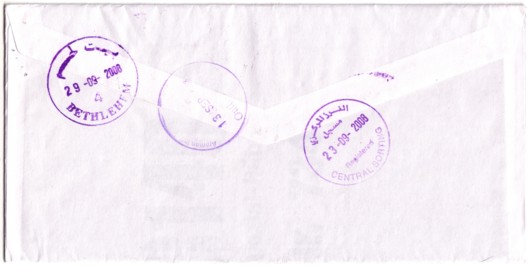
|
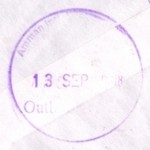
Retourbrief "via Jordan" mit Durchgangstempel "Amman Int ... Outbound ... 13 SEP 2008"; allerdings kein Beweis für ein diektes Routing über Jordanien.
|
|
|
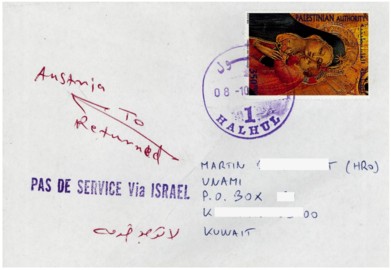
|
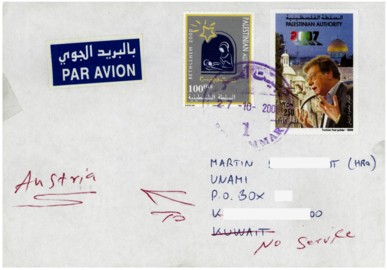
|
| Zwei Briefe von Beit Ummar und Halhul, direkt nach Kuwait gerichte: beide gingen zurück an die Absernderadresse in Wien. Ein Hinweis, daß der Wege über Jordanien (noch?) nicht funktioniert...
Abbildungen: Martin. |
|
|
|
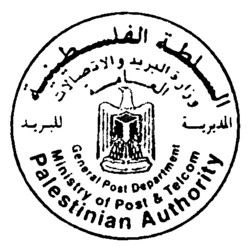
|
|
|
Trotz aller dieser Schwierigkeiten und Behinderungen konnte die palästinensische Post ihr Serviceangebot (Gebühren: Tariff 2012) verbreitern und neue Postämter eröffnen. Nach offiziellen Angaben:
- Allgemeine Postdienstleistungen:
- Inlandsbriefe und -postkarten
- Auslandsbriefe und -postkarten
- Auslandssendungen per Luftpost
- Blindensendungen
- Drucksachen
- Inlandspäckchen und -pakete
- Auslandspäckchen und -pakete (nur in Richtung Palästina)
- Zusatzdienstleistungen:
- Einschreiben
- Wertsendungen
- Rückschein
- Eilsendungen
- Sonstige Postdienstleistungen:
- Fax
- Inlandstelegramme
- Postfächer
- Geplante Leistungen:
- Auslandspäckchen und -pakete (per Luftpost)
- Expresssendungen (EMS Express Mail Service)
Die Zahl der Postämter wurde in den ersten drei Jahren um 33 gesteigert. Somit standen 2004 insgesamt 82 Postanstalten (Detailaufstellung) zur Verfügung der palästinensischen Bevölkerung; laufend kommen Neue hinzu.
Nach offiziellen Angaben gab es im Jahre 2006 insgesamt 99 (77+22)
Mail Service Centers und 238 (221+17) Mail Service Divisions.
Mit Stand 2008 existieren insgesamt 95 (73+22) Postanstalten. Die folgende Tabelle führt zusätzlich auch die Anzahl der Orte mit über 2500 Einwohnern ohne Postanstalt (OV) auf (Detailaufstellung).
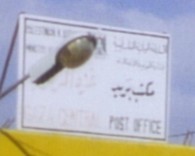
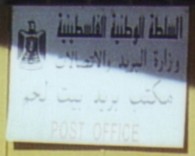
|
| Bezirk |
94 |
04 |
08 |
OV |
Veränderungen |
| North Gaza |
3 |
4 |
4 |
2 |
Jabalia (1999) |
| Gaza |
4 |
4 |
5 |
3 |
Alremal (closed 1996), Omer El Mokhtar (1996), Central Sorting Office |
| Deir el-Balah |
2 |
5 |
5 |
2 |
Alburage (1994), Almghazi (1995), Alzewaida (1995) |
| Khan Yunis |
2 |
6 |
5 |
5 |
Abasan Alkabira (1995), Algrara (1995), Alamel (1995–?), Khuzaa (1997) |
| Rafah |
1 |
3 |
3 |
3 |
Alawda Crossing (1995–?), Tal El Soltan (1995), Terminal Rafah (1995–1998?) |
| Gazastreifen |
12 |
22 |
22 |
15 |
|
| Jenin |
5 |
10 |
12 |
14 |
Alzebabda (1995), Alyamoon (1998), Sielet Alharethiya (1998), Maythelon (2003), Kfer Raei (2003), Ajja (2003), Alkafreyat (2005) |
| Tubas |
1 |
2 |
2 |
2 |
Alfar'a Camp (2005?) |
| Tulkarm |
4 |
7 |
8 |
10 |
Baga Shargeia (1997), Balaa (1998), Qeffin (2001), Illar (2005) |
| Qalqilya |
2 |
4 |
7 |
2 |
Hebla (1997), Kefer Qaddom (2003), Jayyus (2004), Hajja (2005), Kafr Thulth (2005)
|
| Salfit |
2 |
2 |
3 |
4 |
Bedia (1995), Deir Istiya (2005) |
| Nablus |
1 |
3 |
5 |
24 |
Beit Amraen (1997), Asira Ashamaliya (?), Burqa (2005) |
| Ramallah & Al-Bireh |
8 |
13 |
14 |
27 |
Ramallah Government Complex (1996), Ebwin (1997), Mazrae Sharqia (2001), Beir Nbala (2001), Babi Zaed (2002), Central Sorting Office, Beit Liqya (2005) |
| Jericho |
1 |
2 |
1 |
3 |
Alkarama Crossing (1999–?) |
| Jerusalem |
2 |
2 |
3 |
12 |
Alram (closed 1995), Biddu (2005?) |
| Bethlehem |
3 |
4 |
5 |
11 |
Zatera (1997), Al-'Ubeidiya (2005) |
| Hebron |
7 |
11 |
13 |
15 |
Alsamoa (1997), Haram Ibrahimi (2002), Sorif (2003), Bani Naem (2003), Ishna (2004), Beit Ula (2005) |
| Westbank |
37 |
60 |
73 |
124 |
|
| PNA |
49 |
82 |
95 |
139 |
|
|
|
|
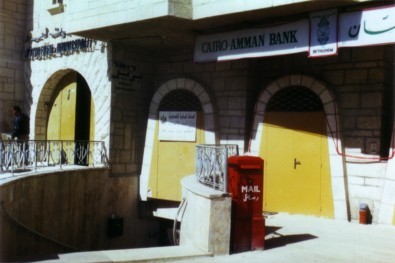 |
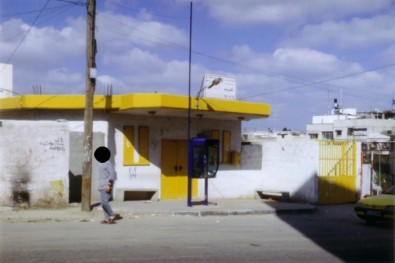 |
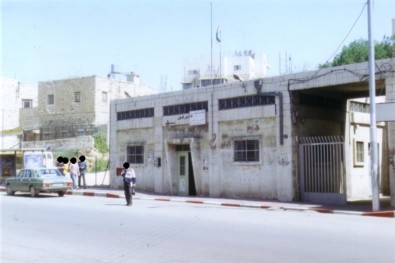 |
| Die Fotoaufnahmen wurden freundlicherweise von Martin Bohnstedt zur Verfügung gestellt. |
|
|
Im Jahre 2010 begannen Planungen für die Einführung eines Postleitzahlsystems. Unabhängig von den auf älteren Einschreibzetteln bekannten Postamtsnummern, wurde ein dreistelliges System entwickelt Die Hunterderstelle identifiziert dabei nicht unbedingt das Governorat, die Zehner- und Einerstellen Städte, Dörfer oder Gruppen von Dörfern, in den größeren Städten auch einzelne Stadtteile. Das Ministerium veröfentliche am 6. Januar 2011 eine
Karte sowie Listen mit Postleitzahlgebieten. Ab Juni 2011 wurden die aktuellen Version via Datanbank und detaillieren Karten veröffentlicht: "Postal coding system in Palestine" und Zinnar Address Server.
|
|
The Ministry of Communications and Information Technology developed a national system of postcodes as part of a project funded by the U.S. Agency for International Development. The importance of this project is that it constitutes a major step for the establishment of a modern Palestinian addressing system, which is essential to the work of the Palestine Post, as well as a key component of e-government to unify data in all government records.
The project provides the encoding for each postal area in the West Bank and Gaza Strip. The Palestinian postcode consists of three digits from 100–999, so dividing up the West Bank and Gaza Strip into 900 postal areas, eg. Bethlehem Governorate is divided into 50 areas (from 150–199) and Jenin into 100 areas (200–299).
The postcode system is the cornerstone for the ministry to work in the current period of building an automated addressing system of the West Bank and Gaza Strip to be available for use and benefit of all.
An automated labeling system will enable the user to search and browse postal areas of the West Bank and Gaza Strip through an interactive map on the Internet. Other types of data such as street names and numbers of buildings will be added on an interactive map enabling the user to access the addresses easily.
The system also will provide a fertile creative environment for the private sector for development and innovation in the field of software and applications, especially those based on geo-tagging data.
Quelle: Ministry of Telecom & Information Technology, 6.01.2011.
|
|
|
|
|
Die Markenausgaben:
- 1994 (14 Hauptnummern, 1 Block, 6 Dienstmarken) Im Aufbau!
- 1995 (28 Hauptnummern, 2 Blocks) Im Aufbau!
- 1996 (24 Hauptnummern, 4 Blocks) Im Aufbau!
- 1997 (14 Hauptnummern, 1 Block) Im Aufbau!
- 1998 (20 Hauptnummern, 4 Blocks) Im Aufbau!
- 1999 (37 Hauptnummern, 2 Blocks) Im Aufbau!
- 2000 (35 Hauptnummern, 3 Blocks, 1 Prestige-Markenheftchen) Im Aufbau!
- 2001 (24 Hauptnummern, 3 Blocks) Im Aufbau!
- 2002 (7 Hauptnummern, 1 Block) Im Aufbau!
- 2003 (8 Hauptnummern, 1 Block) Im Aufbau!
- 2004 (keine Ausgaben) Im Aufbau!
- 2005 (3 Blocks) Im Aufbau!
- 2007 (keine Ausgaben) Im Aufbau!
- 2008 (4 Marken) (in Bearbeitung)
- 2009 (4 Marken, 1 Block sowie 4 Marken, 1 Block unverausgabt und 5 Marken, 1 Block)
- 2010 (8 Marken und 20 Marken, 4 Blocks)
- 2011 (4 Marken, 2 Blocks und 40 Marken, 3 Blocks)
- 2012 (4 Marken, 3 Blocks, 1 Prestige-Markenheftchen, sowie 5 Marken unverausgabt und 16 Marken, 2 Blocks)
- 2013 (6 Marken, 2 Blocks) (in Bearbeitung)
- 2014 (6 Marken, 4 Blocks) (in Bearbeitung)
- Fälschungen (Papst Johannes Paul II, Chess, Fauna)

- Preisübersicht (Liste realistischer Marktpreise)

|
|

 Nach Beendung der Militärverwaltung in der A- und (später) der B-Zone etablierte sich die palästinensische Postverwaltung.
Nach Beendung der Militärverwaltung in der A- und (später) der B-Zone etablierte sich die palästinensische Postverwaltung. 






